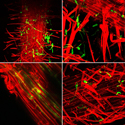Ver ítem
- xmlui.general.dspace_homeCentros e Institutos de InvestigaciónCICVyA. Centro de Investigación en Ciencias Veterinarias y AgronómicasInstituto de BiotecnologíaArtículos científicosxmlui.ArtifactBrowser.ItemViewer.trail
- Inicio
- Centros e Institutos de Investigación
- CICVyA. Centro de Investigación en Ciencias Veterinarias y Agronómicas
- Instituto de Biotecnología
- Artículos científicos
- Ver ítem
Salicylic acid determines differential senescence produced by two turnip mosaic virus strains involving reactive oxygen species and early transcriptomic changes
Resumen
Losses produced by virus diseases depend mostly on symptom severity. Turnip mosaic virus (TuMV) is one of the most damaging and widespread potyvirus infecting members of the family Brassicaceae, including Arabidopsis thaliana. We used JPN1 and UK1 TuMV strains to characterize viral infections regarding symptom development, senescence progression, antioxidant response, reactive oxygen species (ROS) accumulation, and transcriptional profiling. Both
[ver mas...]
Losses produced by virus diseases depend mostly on symptom severity. Turnip mosaic virus (TuMV) is one of the most damaging and widespread potyvirus infecting members of the family Brassicaceae, including Arabidopsis thaliana. We used JPN1 and UK1 TuMV strains to characterize viral infections regarding symptom development, senescence progression, antioxidant response, reactive oxygen species (ROS) accumulation, and transcriptional profiling. Both isolates, despite accumulating similar viral titers, induced different symptomatology and strong differences in oxidative status. Early differences in several senescenceassociated
genes linked to the ORE1 and ORS1 regulatory networks as well as persistent divergence in key ROS production and scavenging systems of the plant were detected. However, at a later stage, both strains induced nutrient competition, indicating that senescence rates are influenced by different mechanisms upon viral infections. Analyses of ORE1 and ORS1 levels in infected Brassica juncea plants showed a similar pattern, suggesting a conserved differential response to both strains in Brassicaceae spp. Transcriptional analysis of the ORE1 and ORS1 regulons showed similarities between salicylic acid (SA) response and the early induction triggered by UK1, the most severe strain. By means of SA-defective NahG transgenic plants, we found that differential senescence progression and ROS accumulation between strains rely on an intact SA pathway.
[Cerrar]

Autor
Manacorda, Carlos Augusto;
Mansilla, Carmen;
Debat, Humberto Julio;
Zavallo, Diego;
Sánchez, Flora;
Ponz, Fernando;
Asurmendi, Sebastian;
Fuente
Molecular plant-microbe interactions 26 (12) : 1486-1498. (2013)
Fecha
2013-12
ISSN
0894-0282
1943-7706 (online version)
1943-7706 (online version)
Formato
pdf
Tipo de documento
artículo
Palabras Claves
Derechos de acceso
Abierto
 Excepto donde se diga explicitamente, este item se publica bajo la siguiente descripción: Creative Commons Attribution-NonCommercial-ShareAlike 2.5 Unported (CC BY-NC-SA 2.5)
Excepto donde se diga explicitamente, este item se publica bajo la siguiente descripción: Creative Commons Attribution-NonCommercial-ShareAlike 2.5 Unported (CC BY-NC-SA 2.5)


